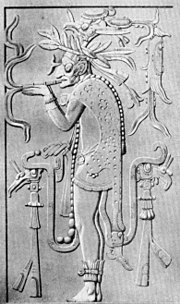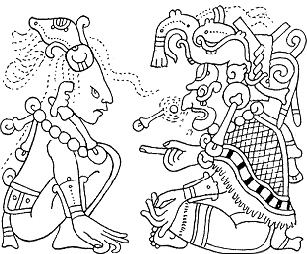
Maya or Mayan mythology is part of Mesoamerican mythology and comprises all of the Maya tales in which personified forces of nature, deities, and the heroes interacting with these play the main roles. The myths of the era have to be reconstructed from iconography. Other parts of Mayan oral tradition are not considered here.

Kʼawiil, in the Post-Classic codices corresponding to God K, is a Maya deity identified with lightning, serpents, fertility and maize. He is characterized by a zoomorphic head, with large eyes, long, upturned snout and attenuated serpent foot. A torch, stone celt, or cigar, normally emitting smoke, comes out of his forehead, while a serpent leg represents a lightning bolt. In this way, Kʼawiil personifies the lightning axe both of the rain deity and of the king as depicted on his stelae.

Huracan, often referred to as U Kʼux Kaj, the "Heart of Sky", is a Kʼicheʼ Maya god of wind, storm, fire and one of the creator deities who participated in all three attempts at creating humanity. He also caused the Great Flood after the second generation of humans angered the gods. He supposedly lived in the windy mists above the floodwaters and repeatedly invoked "earth" until land came up from the seas.
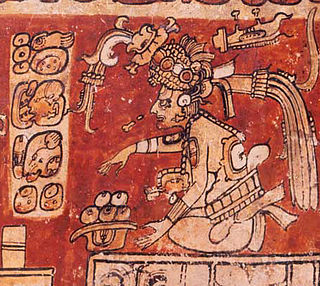
Itzamna is, in Maya mythology, an upper god and creator deity thought to reside in the sky. Itzamna is one of the most important gods in the Classic and Postclassic Maya pantheon. Although little is known about him, scattered references are present in early-colonial Spanish reports (relaciones) and dictionaries. Twentieth-century Lacandon lore includes tales about a creator god who may be a late successor to him. In the pre-Spanish period, Itzamna was often depicted in books and in ceramic scenes derived from them. Before the names of the Maya deities were deciphered, Itzamna was known as "god D", and is still sometimes referred to as "god D" by archeologists.
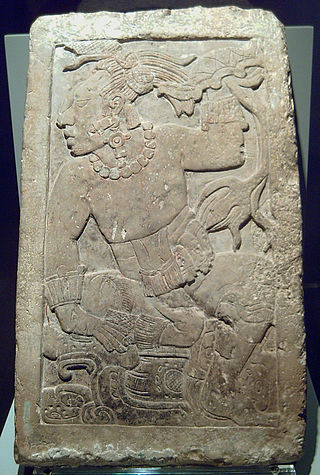
Bacab is the generic Yucatec Maya name for the four prehispanic aged deities of the interior of the earth and its water deposits. The Bacabs have more recent counterparts in the lecherous, drunken old thunder deities of the Gulf Coast regions. The Bacabs are also referred to as Pauahtuns.

Ixchel or Ix Chel is the 16th-century name of the aged jaguar Goddess of midwifery and medicine in ancient Maya culture. In a similar parallel, she corresponds, to Toci Yoalticitl "Our Grandmother the Nocturnal Physician", an Aztec earth Goddess inhabiting the sweatbath, and is related to another Aztec Goddess invoked at birth, viz. Cihuacoatl. In Taube's revised Schellhas-Zimmermann classification of codical deities, Ixchel corresponds to the Goddess O.

Chaac is the name of the Maya god of rain, thunder, and lighting. With his lightning axe, Chaac strikes the clouds, causing them to produce thunder and rain. Chaac corresponds to Tlaloc among the Aztecs.

Kinich Ahau is the 16th-century Yucatec name of the Maya sun god, designated as God G when referring to the codices. In the Classic period, God G is depicted as a middle-aged man with an aquiline nose, large square eyes, cross-eyed, and a filed incisor in the upper row of teeth. Usually, there is a k'in ('sun')-infix, sometimes in the very eyes. Among the southern Lacandons, Kinich Ahau continued to play a role in narrative well into the second half of the twentieth century.

World trees are a prevalent motif occurring in the mythical cosmologies, creation accounts, and iconographies of the pre-Columbian cultures of Mesoamerica. In the Mesoamerican context, world trees embodied the four cardinal directions, which also serve to represent the fourfold nature of a central world tree, a symbolic axis mundi which connects the planes of the Underworld and the sky with that of the terrestrial realm.

The traditional Maya or Mayan religion of the extant Maya peoples of Guatemala, Belize, western Honduras, and the Tabasco, Chiapas, Quintana Roo, Campeche and Yucatán states of Mexico is part of the wider frame of Mesoamerican religion. As is the case with many other contemporary Mesoamerican religions, it results from centuries of symbiosis with Roman Catholicism. When its pre-Hispanic antecedents are taken into account, however, traditional Maya religion has already existed for more than two and a half millennia as a recognizably distinct phenomenon. Before the advent of Christianity, it was spread over many indigenous kingdoms, all with their own local traditions. Today, it coexists and interacts with pan-Mayan syncretism, the 're-invention of tradition' by the Pan-Maya movement, and Christianity in its various denominations.

Ancient Maya art is the visual arts of the Maya civilization, an eastern and south-eastern Mesoamerican culture made up of a great number of small kingdoms in present-day Mexico, Guatemala, Belize and Honduras. Many regional artistic traditions existed side by side, usually coinciding with the changing boundaries of Maya polities. This civilization took shape in the course of the later Preclassic Period, when the first cities and monumental architecture started to develop and the hieroglyphic script came into being. Its greatest artistic flowering occurred during the seven centuries of the Classic Period.
Hun Hunahpu, or 'Head-Apu I' is a figure in Mayan mythology. According to Popol Vuh he was the father of the Maya Hero Twins, Head-Apu and Xbalanque. As their shared calendrical day name suggests, Head-Apu I was the father of Head-Apu. He is believed to be the father of the twins' half-brothers and the patrons of artisans and writers, Hun-Chowen and Hun-Batz. Head-Apu I is paired with his brother, Vucub-Hunahpu, Head-Apu VII. The brothers were tricked in the Dark House by the lords of the Underworld (Xibalba) and sacrificed. Head-Apu I's head was suspended in a trophy tree and changed to a calabash. Its saliva impregnated Xquic, a daughter of one of the lords of Xibalba. She fled the Underworld and conceived the Twins. After defeating the Underworld lords, the twins recovered the remains of their father and their father's brother, but could not resuscitate them.

Tortuguero is an archaeological site in southernmost Tabasco, Mexico which supported a Maya city during the Classic period. The site is noteworthy for its use of the B'aakal emblem glyph also found as the primary title at Palenque. The site has been heavily damaged by looting and modern development; in the 1960s, a cement factory was built directly on top of the site.

Like other Mesoamerican peoples, the traditional Maya recognize in their staple crop, maize, a vital force with which they strongly identify. This is clearly shown by their mythological traditions. According to the 16th-century Popol Vuh, the Hero Twins have maize plants for alter egos and man himself is created from maize. The discovery and opening of the Maize Mountain – the place where the corn seeds are hidden – is still one of the most popular of Maya tales. In the Classic period, the maize deity shows aspects of a culture hero.

The traditional Mayas generally assume the Moon to be female, and the Moon's perceived phases are accordingly conceived as the stages of a woman's life. The Maya moon goddess wields great influence in many areas. Being in the image of a woman, she is associated with sexuality and procreation, fertility and growth, not only of human beings, but also of the vegetation and the crops. Since growth can also cause all sorts of ailments, the moon goddess is also a goddess of disease. Everywhere in Mesoamerica, including the Mayan area, she is specifically associated with water, be it wells, rainfall, or the rainy season. In the codices, she has a terrestrial counterpart in goddess I.

The pre-Columbian Maya religion knew various jaguar gods, in addition to jaguar demi-gods, (ancestral) protectors, and transformers. The main jaguar deities are discussed below. Their associated narratives are still largely to be reconstructed. Lacandon and Tzotzil-Tzeltal oral tradition are particularly rich in jaguar lore.
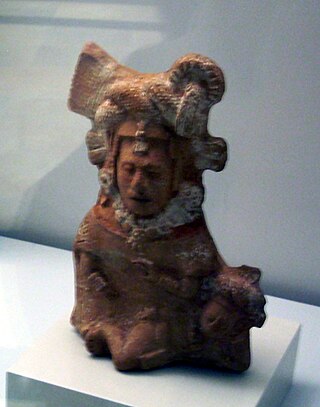
Goddess I is the Taube's Schellhas-Zimmermann letter designation for one of the most important Maya deities: a youthful woman to whom considerable parts of the post-Classic codices are dedicated, and who equally figures in Classic Period scenes. Based on her representation in codical almanacs, she is considered to represent vital functions of the fertile woman, and to preside over eroticism, human procreation, and marriage. Her aged form is associated with weaving. Goddess I could, perhaps, be seen as a terrestrial counterpart to the Maya moon goddess. In important respects, she corresponds to Xochiquetzal among the Aztecs, a deity with no apparent connection to the moon.

Ek Chuaj, also known as Ek Chuah, Ekchuah, God M according to the Schellhas-Zimmermann-Taube classification of codical gods, is a Postclassic Maya merchant deity as well as a patron of cacao. Ek Chuaj is part of a pantheon of Maya deities that have been depicted in hieroglyphs and artwork of various Maya sites and has been interpreted as a significant part of Maya religion.
Chac Chel is a powerful and ancient Mayan goddess of creation, destruction, childbirth, water, weaving and spinning, healing, and divining. She is half of the original Creator Couple, seen most often as the wife of Chaac, who is the pre-eminent god of lightning and rain, although she is occasionally paired with the Creator God Itzamna in the Popol Vuh, a recording of the myths of the highland Maya. This highlights her importance, as dualities such as male/female and husband/wife were extremely important to the Maya, and one cannot function without the other. Chac Chel is also called Goddess O by many Mayanists and she is the aged, grandmotherly counterpart to the young goddess of childbirth and weaving, Ix Chel. Most popular in the Late Classic and Postclassic Periods, she is most often depicted in scenes in the Dresden Codex and Madrid Codex. Depictions of her, and burial goods related to her, have also been found in Chichen Itza, the Balankanche Cave near Chichen Itza, Tulum, The Margarita Tomb in Copan, and in Yaxchilan.
